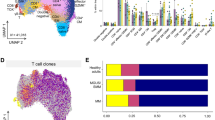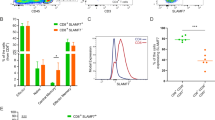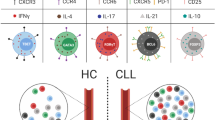Abstract
Tumour-induced dysfunction of cytotoxic T cells in patients with multiple myeloma (MM) may contribute to immune escape and be responsible for the lack of therapeutic efficacy of immune checkpoint blockade. We therefore investigated dysfunctional clonal T cells in MM and demonstrated immunosenescence but not exhaustion as a predominant feature. T-cell clones were detected in 75% of MM patients and their prognostic significance was revalidated in a new post-immunomodulatory drug cohort. The cells exhibited a senescent secretory effector phenotype: KLRG-1+/CD57+/CD160+/CD28−. Normal-for-age telomere lengths indicate that senescence is telomere independent and potentially reversible. p38-mitogen-activated protein kinase, p16 and p21 signalling pathways known to induce senescence were not elevated. Telomerase activity was found to be elevated and this may explain how normal telomere lengths are maintained in senescent cells. T-cell receptor signalling checkpoints were normal but elevated SMAD levels associated with T-cell inactivation were detected and may provide a potential target for the reversal of clonal T-cell dysfunction in MM. Low programmed death 1 and cytotoxic T-lymphocyte-associated antigen 4 expression detected on T-cell clones infers that these cells are not exhausted but suggests that there would be a suboptimal response to immune checkpoint blockade in MM. Our data suggest that other immunostimulatory strategies are required in MM.
This is a preview of subscription content, access via your institution
Access options
Subscribe to this journal
Receive 12 print issues and online access
$259.00 per year
only $21.58 per issue
Buy this article
- Purchase on Springer Link
- Instant access to full article PDF
Prices may be subject to local taxes which are calculated during checkout





Similar content being viewed by others
References
Kofler DM, Chmielewski M, Rappl G, Hombach A, Riet T, Schmidt A et al. CD28 costimulation impairs the efficacy of a redirected T-cell antitumor attack in the presence of regulatory T cells which can be overcome by preventing Lck activation. Mol Ther 2011; 19: 760–767.
Motz GT, Coukos G . Deciphering and reversing tumor immune suppression. Immunity 2013; 39: 61–73.
Brown R, Pope B, Murray A, Esdale W, Sze DM, Gibson J et al. Dendritic cells from patients with myeloma are numerically normal but functionally defective as they fail to up-regulate CD80 (B7-1) expression after huCD40LT stimulation because of inhibition by transforming growth factor-beta1 and interleukin-10. Blood 2001; 98: 2992–2998.
Bryant C, Suen H, Brown R, Yang S, Favaloro J, Aklilu E et al. Long-term survival in multiple myeloma is associated with a distinct immunological profile, which includes proliferative cytotoxic T-cell clones and a favourable Treg/Th17 balance. Blood Cancer J 2013; 3: e148.
Favaloro J, Brown R, Aklilu E, Yang S, Suen H, Hart D et al. Myeloma skews regulatory T and pro-inflammatory T helper 17 cell balance in favor of a suppressive state. Leuk Lymphoma 2014; 55: 1090–1098.
Brown R, Kabani K, Favaloro J, Yang S, Ho PJ, Gibson J et al. CD86+ or HLA-G+ can be transferred via trogocytosis from myeloma cells to T cells and are associated with poor prognosis. Blood 2012; 120: 2055–2063.
Favaloro J, Liyadipitiya T, Brown R, Yang S, Suen H, Woodland N et al. Myeloid derived suppressor cells are numerically, functionally and phenotypically different in patients with multiple myeloma. Leuk Lymphoma 2014; 55: 2893–2900.
Brown R, Suen H, Favaloro J, Yang S, Ho PJ, Gibson J et al. Trogocytosis generates acquired regulatory T cells adding further complexity to the dysfunctional immune response in multiple myeloma. Oncoimmunology 2012; 1: 1658–1660.
Brown RD, Joshua DE . T-cell responses in myeloma. In: Munshi N, Anderson K (eds). Advances in Biology and Therapy of Multiple Myeloma vol. 2. Springer: New York, NY, USA, 2013, pp 3–24.
Crespo J, Sun H, Welling TH, Tian Z, Zou W . T-cell anergy, exhaustion, senescence, and stemness in the tumor microenvironment. Curr Opin Immunol 2013; 25: 214–221.
Choi S, Schwartz RH . Molecular mechanisms for adaptive tolerance and other T-cell anergy models. Semin Immunol 2007; 19: 140–152.
Schwartz RH . T-cell anergy. Annu Rev Immunol 2003; 21: 305–334.
Blackburn SD, Shin H, Haining WN, Zou T, Workman CJ, Polley A et al. Coregulation of CD8+ T-cell exhaustion by multiple inhibitory receptors during chronic viral infection. Nat Immunol 2009; 10: 29–37.
Fourcade J, Sun Z, Pagliano O, Guillaume P, Luescher IF, Sander C et al. CD8(+) T cells specific for tumor antigens can be rendered dysfunctional by the tumor microenvironment through upregulation of the inhibitory receptors BTLA and PD-1. Cancer Res 2012; 72: 887–896.
Woo S-R, Turnis ME, Goldberg MV, Bankoti J, Selby M, Nirschl CJ et al. Immune inhibitory molecules LAG-3 and PD-1 synergistically regulate T-cell function to promote tumoral immune escape. Cancer Res 2012; 72: 917–927.
Dock JN, Effros RB . Role of CD8 T-cell replicative senescence in human aging and in HIV-mediated immunosenescence. Aging Dis 2011; 2: 382–397.
Herbig U, Jobling WA, Chen BPC, Chen DJ, Sedivy JM . Telomere shortening triggers senescence of human cells through a pathway involving ATM, p53, and p21CIP1, but not p16INK4a. Mol Cell 2004; 14: 501–513.
Campisi J, d'Adda di Fagagna F . Cellular senescence: when bad things happen to good cells. Nat Rev Mol Cell Biol 2007; 8: 729–740.
Salminen A, Kauppinen A, Kaarniranta K . Emerging role of NF-κB signaling in the induction of senescence-associated secretory phenotype (SASP). Cell Signal 2012; 24: 835–845.
Brown R, Yuen E, Nelson M, Gibson J, Joshua D . The prognostic significance of T-cell receptor beta gene rearrangements and idiotype-reactive T cells in multiple myeloma. Leukemia 1997; 11: 1312–1317.
Raitakari M, Brown RD, Gibson J, Joshua DE . T cells in myeloma. Hematol Oncol 2003; 21: 33–42.
Joshua D, Brown R, Sze DM, Raitakari M, Gibson J, Ho PJ et al. The role of T cells in myeloma. Hematol J 2003; 4: S26–S28.
Li Y, Yang LJ, Chen SH, Zhang YP, Zhang XL, Luo GX . T-cell receptor Vbeta repertoire usage and clonal expansion of T cells in chronic myelogenous leukemia. Chin Med J 2004; 117: 840–843.
Mustjoki S, Ekblom M, Arstila TP, Dybedal I, Epling-Burnette PK, Guilhot F et al. Clonal expansion of T/NK-cells during tyrosine kinase inhibitor dasatinib therapy. Leukemia 2009; 23: 1398–1405.
Li J, DM-Y Sze, Brown RD, Cowley MJ, Kaplan W, Mo S-L et al. Clonal expansions of cytotoxic T cells exist in the blood of patients with Waldenström macroglobulinemia but exhibit anergic properties and are eliminated by nucleoside analogue therapy. Blood 2010; 115: 3580–3588.
Epling-Burnette P, Painter JS, Rollison DE, Ku E, Vendron D, Widen R et al. Prevalence and clinical association of clonal T-cell expansions in myelodysplastic syndrome. Leukemia 2007; 21: 659–667.
Vries Ad, Langerak AW, Verhaaf B, Niemeyer CM, Stary J, Schmiegelow K et al. T-cell receptor Vbeta CDR3 oligoclonality frequently occurs in childhood refractory cytopenia (MDS-RC) and severe aplastic anemia. Leukemia 2008; 22: 1170–1174.
Brown R, Spencer A, Ho PJ, Kennedy N, Kabani K, Yang S et al. Prognostically significant cytotoxic T-cell clones are stimulated after thalidomide therapy in patients with multiple myeloma. Leuk Lymphoma 2009; 50: 1860–1864.
Sze D, Giesajtis G, Brown RD, Raitakari M, Gibson J, Ho J et al. Clonal cytotoxic T cells are expanded in myeloma and reside in the CD8(+)CD57(+)CD28(-) compartment. Blood 2001; 98: 2817–2827.
Aviv A, Hunt SC, Lin J, Cao X, Kimura M, Blackburn E . Impartial comparative analysis of measurement of leukocyte telomere length/DNA content by Southern blots and qPCR. Nucleic Acids Res 2011; 39: e134.
Cawthon RM . Telomere measurement by quantitative PCR. Nucleic Acids Res 2002; 30: e47.
Au-Yeung BB, Deindl S, Hsu L-Y, Palacios EH, Levin SE, Kuriyan J et al. The structure, regulation, and function of ZAP-70. Immunol Rev 2009; 228: 41–57.
Qu CK . The SHP-2 tyrosine phosphatase: signaling mechanisms and biological functions. Cell Res 2000; 10: 279–288.
Guy CS, Vignali DA . Organization of proximal signal initiation at the TCR:CD3 complex. Immunol Rev 2009; 232: 7–21.
Tzachanis D, Freeman GJ, Hirano N, van Puijenbroek AA, Delfs MW, Berezovskaya A et al. Tob is a negative regulator of activation that is expressed in anergic and quiescent T cells. Nat Immunol 2001; 2: 1174–1182.
Pettiford SM, Herbst R . The protein tyrosine phosphatase HePTP regulates nuclear translocation of ERK2 and can modulate megakaryocytic differentiation of K562 cells. Leukemia 2003; 17: 366–378.
Boise LH, González-García M, Postema CE, Ding L, Lindsten T, Turka LA et al. bcl-x, a bcl-2-related gene that functions as a dominant regulator of apoptotic cell death. Cell 1993; 74: 597–608.
Di Mitri D, Azevedo RI, Henson SM, Libri V, Riddell NE, Macaulay R et al. Reversible senescence in human CD4+CD45RA+CD27− memory T cells. J Immunol 2011; 187: 2093–2100.
Henson SM, Lanna A, Riddell NE, Franzese O, Macaulay R, Griffiths SJ et al. p38 signaling inhibits mTORC1-independent autophagy in senescent human CD8(+) T cells. J Clin Invest 2014; 124: 4004–4016.
Henson SM, Macaulay R, Riddell NE, Nunn CJ, Akbar AN . Blockade of PD-1 or p38 MAP kinase signaling enhances senescent human CD8(+) T-cell proliferation by distinct pathways. Eur J Immunol 2015; 45: 1441–1451.
Mizoguchi H, O'Shea JJ, Longo DL, Loeffler CM, McVicar DW, Ochoa AC . Alterations in signal transduction molecules in T lymphocytes from tumor-bearing mice. Science 1992; 258: 1795–1798.
Mozaffari F, Hansson L, Kiaii S, Ju X, Rossmann ED, Rabbani H et al. Signalling molecules and cytokine production in T cells of multiple myeloma-increased abnormalities with advancing stage. Br J Haematol 2004; 124: 315–324.
Moro-Garcia MA, Alonso-Arias R, Lopez-Larrea C . Molecular mechanisms involved in the aging of the T-cell immune response. Curr Genomics 2012; 13: 589–602.
McKarns SC, Schwartz RH, Kaminski NE . Smad3 is essential for TGF-β1 to suppress IL-2 production and TCR-induced proliferation, but not IL-2-induced proliferation. J Immunol 2004; 172: 4275–4284.
Beausejour CM, Krtolica A, Galimi F, Narita M, Lowe SW, Yaswen P et al. Reversal of human cellular senescence: roles of the p53 and p16 pathways. EMBO J 2003; 22: 4212–4222.
Migliaccio M, Raj K, Menzel O, Rufer N . Mechanisms that limit the in vitro proliferative potential of human CD8+ T lymphocytes. J Immunol 2005; 174: 3335–3343.
Rovillain E, Mansfield L, Caetano C, Alvarez-Fernandez M, Caballero OL, Medema RH et al. Activation of nuclear factor-kappa B signalling promotes cellular senescence. Oncogene 2011; 30: 2356–2366.
Kuilman T, Michaloglou C, Vredeveld LC, Douma S, van Doorn R, Desmet CJ et al. Oncogene-induced senescence relayed by an interleukin-dependent inflammatory network. Cell 2008; 133: 1019–1031.
Grandori C, Wu KJ, Fernandez P, Ngouenet C, Grim J, Clurman BE et al. Werner syndrome protein limits MYC-induced cellular senescence. Genes Dev 2003; 17: 1569–1574.
Grange M, Giordano M, Mas A, Roncagalli R, Firaguay G, Nunes JA et al. Control of CD8 T-cell proliferation and terminal differentiation by active STAT5 and CDKN2A/CDKN2B. Immunology 2015; 145: 543–557.
Schietinger A, Greenberg PD . Tolerance and exhaustion: defining mechanisms of T-cell dysfunction. Trends Immunol 2014; 35: 51–60.
Woo SR, Turnis ME, Goldberg MV, Bankoti J, Selby M, Nirschl CJ et al. Immune inhibitory molecules LAG-3 and PD-1 synergistically regulate T-cell function to promote tumoral immune escape. Cancer Res 2012; 72: 917–927.
Teramo A, Gattazzo C, Passeri F, Lico A, Tasca G, Cabrelle A et al. Intrinsic and extrinsic mechanisms contribute to maintain the JAK/STAT pathway aberrantly activated in T-type large granular lymphocyte leukemia. Blood 2013; 121: 3843–3854.
Suen H, Brown R, Yang S, Ho PJ, Gibson J, Joshua D . The failure of immune checkpoint blockade in multiple myeloma with PD-1 inhibitors in a phase 1 study. Leukemia 2015; 29: 1621–1622.
Lesokhin AM, Ansell SM, Armand P, Scott EC, Halwani A, Gutierrez M et al. Preliminary results of a phase I study of nivolumab (BMS-936558) in patients with relapsed or refractory lymphoid malignancies. Blood 2014; 124: 291–291.
Gorgun G, Samur MK, Cowens KB, Paula S, Bianchi G, Anderson JE et al. Lenalidomide enhances immune checkpoint blockade-induced immune response in multiple myeloma. Clin Cancer Res 2015; 21: 4607–4618.
Kao C, Oestreich KJ, Paley MA, Crawford A, Angelosanto JM, Ali MA et al. Transcription factor T-bet represses expression of the inhibitory receptor PD-1 and sustains virus-specific CD8+ T-cell responses during chronic infection. Nat Immunol 2011; 12: 663–671.
Lu P, Youngblood BA, Austin JW, Rasheed Mohammed AU, Butler R, Ahmed R et al. Blimp-1 represses CD8 T-cell expression of PD-1 using a feed-forward transcriptional circuit during acute viral infection. J Exp Med 2014; 211: 515–527.
Intlekofer AM, Takemoto N, Kao C, Banerjee A, Schambach F, Northrop JK et al. Requirement for T-bet in the aberrant differentiation of unhelped memory CD8+ T cells. J Exp Med 2007; 204: 2015–2021.
Acknowledgements
The work was supported by Sydney Foundation for Medical Research and the Cancer Institute of New South Wales.
Author information
Authors and Affiliations
Corresponding author
Ethics declarations
Competing interests
The authors declare no conflict of interest.
Additional information
Supplementary Information accompanies this paper on the Leukemia website
Supplementary information
Rights and permissions
About this article
Cite this article
Suen, H., Brown, R., Yang, S. et al. Multiple myeloma causes clonal T-cell immunosenescence: identification of potential novel targets for promoting tumour immunity and implications for checkpoint blockade. Leukemia 30, 1716–1724 (2016). https://doi.org/10.1038/leu.2016.84
Received:
Revised:
Accepted:
Published:
Issue Date:
DOI: https://doi.org/10.1038/leu.2016.84
This article is cited by
-
The roles of bone remodeling in normal hematopoiesis and age-related hematological malignancies
Bone Research (2023)
-
The immunome of mobilized peripheral blood stem cells is predictive of long-term outcomes and therapy-related myeloid neoplasms in patients with multiple myeloma undergoing autologous stem cell transplant
Blood Cancer Journal (2023)
-
Deciphering mechanisms of immune escape to inform immunotherapeutic strategies in multiple myeloma
Journal of Hematology & Oncology (2022)
-
T-cell counts in peripheral blood at leukapheresis predict responses to subsequent CAR-T cell therapy
Scientific Reports (2022)
-
Immune senescence in multiple myeloma—a role for mitochondrial dysfunction?
Leukemia (2022)



